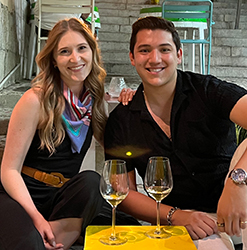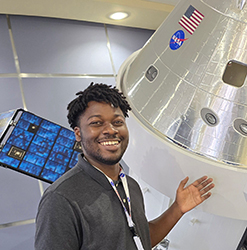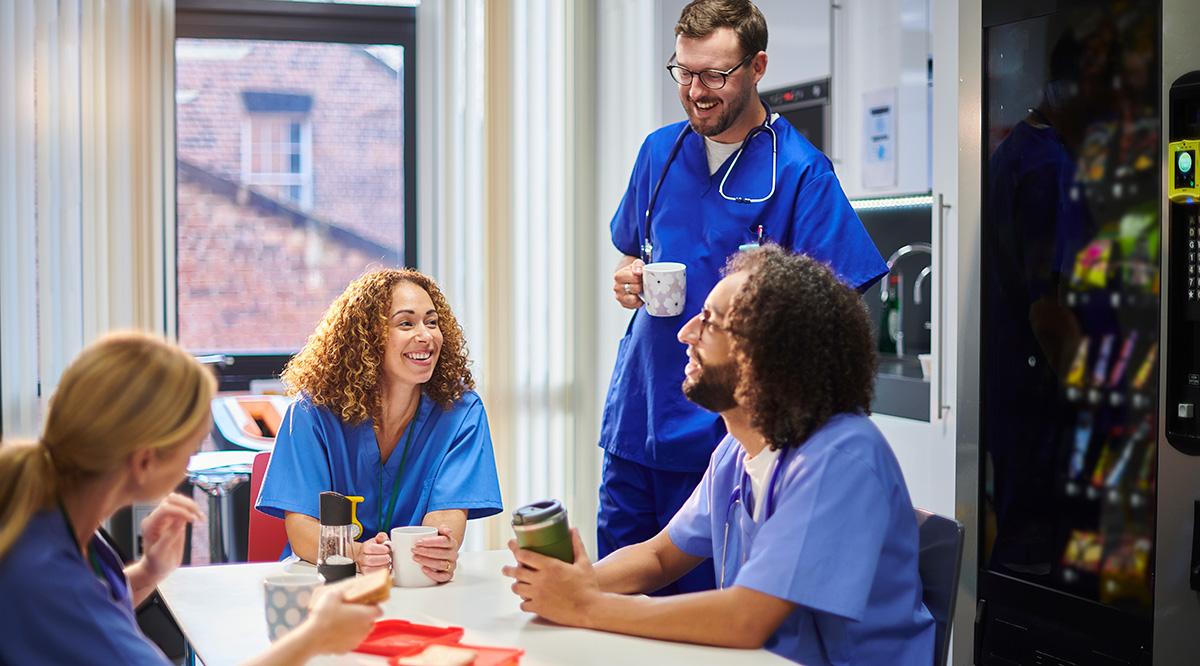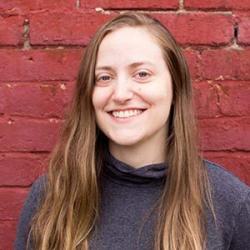Medical students consider a wide range of factors when determining the rank order list they’ll submit for The Match®, the algorithm that will determine where they’ll spend the next three to seven years training in residency. Among them are quality of education and training, level of faculty supervision, opportunities to pursue subspecialties or special interests, location, and patient population, according to survey results published by the National Resident Matching Program® (NRMP), which runs The Match.
But for many students, there’s another overarching consideration that influences their choices: Are the “vibes” good?
The term “vibes,” a slang word that encompasses the intangible feelings that a person, place, or thing inspires, has reemerged in the popular lexicon in the past few years after a long hiatus. A word that dates back to 1960s hippie culture — some attribute its popularity then to the song “Good Vibrations” by the Beach Boys — it is now ubiquitous on social media and in casual conversation. It expresses a positive experience (e.g., “We were vibing” or “It’s a whole vibe”) or a negative one (e.g., “The vibes are off” or “It gave me bad vibes”).
Data from the NRMP 2024 applicant survey show that “goodness of fit” — which represents the overall alignment of the program with the applicant's preferences, including “the vibe" – is an important factor for the majority of applicants when considering rank order. The percentage of survey respondents who indicated that “goodness of fit” was a priority jumped from 69% in 2023 to 81% in 2024.
This mentality is reflected in several Match 2025 sub-Reddit posts, where anonymous users seek feedback from their peers: “Advice appreciated — location vs. vibes,” “Bad vibes from the [program director], but great program,” and “My top program checks all the boxes except vibes. What should I do?”
The AAMC’s Residency Explorer™ tool, which includes a variety of data from residency programs to help applicants identify those with which they may be most aligned, launched a new section in 2024 focused on evaluating personal and professional needs in relation to program offerings. Applicants can use the tool to aid in their ranking of programs based on what’s most important to them.
For Michael Augustin, a fourth-year student at the University at Buffalo Jacobs School of Medicine and Biomedical Sciences (UB Jacobs School) in New York who is applying to radiation oncology residency programs this cycle, good vibes are a requirement.
“If the vibe was not good during the interview, it did not make it on the list,” he says.
Ian Dadeboe, a fourth-year student at the University of Houston (UH) Tilman J. Fertitta Family College of Medicine applying to anesthesiology, has similar feelings.
“Vibes and psychological safety — I’ve been using [the terms] interchangeably,” Dadeboe says. “The vibes just had to fit. Did I think I could be there four years and enjoy my experience?”
No matter what term is used, the feeling a program gives applicants has long carried weight in the ranking decision process, explains Angela H. Jackson, MD, associate dean of student affairs at Boston University (BU) Chobanian & Avedisian School of Medicine. What has changed is that many specialties have shifted to all-virtual interviews since the COVID-19 pandemic.
This is because virtual interviews reduce travel expenses and give applicants an opportunity to interview at more programs.
“It was hard enough [for applicants] to go for a day and get a true sense for the place,” Jackson says. “Programs have done a remarkable job [of organizing virtual interviews and socials, but] it’s different if you’re not actually there.”
So, how are medical students today assessing the vibes of the programs they may train at in a virtual-interview environment? And what are the vibes that students seek?
As the March 5, 2025, deadline to finalize rank order lists approached, AAMCNews spoke with several applicants about their experiences interviewing and how vibes factored into their ranking decisions.
Camaraderie
For several students, one of the key factors used to determine if the program they were interviewing with had good vibes was whether they detected a sense of camaraderie among the residents and some level of comfort between the residents and the faculty. And to take it a step further, whether they could see themselves fitting in with this dynamic.
Ifeoma Ezeilo, a fourth-year student at UB Jacobs School, says it was challenging to pick up on these things over Zoom, but she tried to do so by observing the way the residents spoke to one another and interacted with her. Did a resident’s eyes light up when their coresident joined the Zoom room? Did they have nicknames for one another? Were they making jokes? During one interview, she and a resident chatted about their favorite professional basketball players.
“You could tell the vibes were there,” she says.

Ifeoma Ezeilo is a fourth-year student at the University at Buffalo Jacobs School of Medicine and Biomedical Sciences.
Courtesy of Ifeoma Ezeilo
In fact, Ezeilo says she reordered her top choices “off vibe alone.” As a Black woman, Ezeilo says that the racial diversity among the residents in the program helped her get a sense for whether she’d be welcomed and fit in there.
“You want to make sure people understand you as a person. Do they understand your jokes? Do they get your personality?” she says. “You want to mesh well in an environment.”
Applicants aren’t the only ones assessing vibes. Jessica Heft, MD, a urogynecology and pelvic reconstruction surgeon and director of the obstetrics and gynecology residency program at the University of Florida (UF) College of Medicine, says that each of the interviewers fills out a score card about each interviewee. Among other criteria is one called “intangibles.”
“In medicine we’ve done this awhile,” she says. “When you’ve interviewed a lot of applicants, you get a sixth sense for emotional intelligence.”
This doesn’t mean that there’s a specific “vibe” or personality she’s looking for, though.
“We don’t want cookie-cutter. Different backgrounds add more depth to a program,” she says. “If we’re all the same, it’s a disservice to patients.”
Rather, she’s trying to pick up if the person will be able to work well with patients, coresidents, and faculty.
“You get a feeling: is this somebody who is compassionate and can communicate well?” Heft says. “In the trenches with their coresidents, can they hold it together through the bad times and benefit from good times? I want my residents, in general, working with each other. I don’t want them dreading coming in to work. I want the vibes to be solid.”
Authenticity
Another quality that fell under the “vibes” umbrella for students was a sense of authenticity from faculty and residents. While brief interactions over Zoom can limit the opportunity for a deep connection, students said they’d ask questions to assess the program’s culture.

Madeline Fitzhugh and Jacob Hansen are both fourth-year students at the University of Iowa Roy J. and Lucille A. Carver College of Medicine who are applying to dermatology.
Courtesy of Jacob Hansen
It’s important “for program directors to try to be as genuine as possible,” says Madeline Fitzhugh, a fourth-year student at the University of Iowa (UIowa) Roy J. and Lucille A. Carver College of Medicine who is applying to dermatology. “Everyone is looking for something different in residency, so if a program has a more serious vibe, just genuinely conveying that, as opposed to where the faculty-resident relationships are a bit more casual, portraying that [is helpful].”
Jacob Hansen, also a fourth-year student at UIowa applying to dermatology (and Fitzhugh’s partner), says that to assess different programs’ vibes, he mostly relied on previous in-person experiences doing away rotations at programs or speaking with people he knew already in residency about the programs’ reputations.
“During interviews, everyone is trying to really sell their program, and I don’t know how authentic their presentation is, so I try to take it with a grain of salt,” Hansen says. “A lot goes into making a rank list, and I do feel like vibes did play a large role [for me]. We work very closely with a small number of residents in this specialty, so I would much rather be around people I like and would get along with.”

Rhea Marfatia, a fourth-year student at the University at Buffalo Jacobs School of Medicine and Biomedical Sciences, is applying to internal medicine.
Courtesy of Rhea Marfatia
Rhea Marfatia, a fourth-year student at UB Jacobs School applying to internal medicine, has relied on the experiences of acquaintances who were midway through their intern year. This way she could craft a fuller picture of programs than she felt was possible from participating in virtual interviews and socials alone.
“I’ve gotten a good idea [of program culture] based on their feedback and how they’re enjoying their intern year,” Marfatia says. “Some [programs] surprised me. I was going to rank [them] lower based on prestige or other factors, but the way residents exuded that this is a good place for you, I really felt they were being honest. Places like that could move up my rank list based solely on vibes.”
Wellness
Medical residency has a reputation for its intensity. The difficulty of the work and the long hours alone can push a person to emotional and physical limits. And historically, many residencies have also fostered cultures that emphasized hierarchy and allowed mistreatment of residents. But in recent decades, growing attention to physician burnout and mental health crises, particularly during and after the COVID-19 pandemic, has placed more of a spotlight on resident wellness.
Several students identified that a program’s emphasis on resident well-being, and whether they believed they’d be treated well during residency, as a priority in their selection criteria.
“I wanted to be in a place where the culture wasn’t malignant,” says Shanique Birch, a graduate of the University of Medicine and Health Sciences in the Caribbean island federation of St. Kitts and Nevis. She is applying to emergency medicine. “I don’t mind a tough culture. I can get through anything, but if it’s malignant, you’re not going to learn anything.”

Ian Dadeboe, a fourth-year student at the University of Houston (UH) Tilman J. Fertitta Family College of Medicine, is applying to anesthesiology.
Courtesy of Ian Dadeboe
For Dadeboe, the UH student applying to anesthesiology, his sense of psychological safety was paramount.
“It’s been important for me to always be in a space where it’s safe for me to grow and ask questions,” Dadeboe says. “I want to be at a place that’s supporting me and not making it harder for me to do that.”
Augustin, the UB Jacobs School student applying to radiation oncology, says he was most drawn to places where he got the sense that program directors looked out for their residents’ well-being.
“If the residents are happy, they’ll talk about the program with excitement and the interviewees can feel that vibe,” he says.
But wellness does not always mean happiness, Jackson, the BU dean, is careful to emphasize to her advisees.
“Students talk a lot about whether the residents seemed happy,” Jackson says. “It’s important — you don’t want them to seem miserable — but are they engaged and excited about learning and patient care? You’re not going to be happy as a resident every day of your training. You’re going to have good and bad days. Engagement is a more reliable measure.”
When her advisees are unsure about how to rank the programs they’ve interviewed with, Jackson walks them through what she calls the Idaho exercise. She has them go through and compare programs, but pretend they are just programs “a” and “b,” both located in Idaho. If the name, prestige, and location are taken away, what about the program stands out to the student?
“It’s not that there’s a wrong answer,” she says. And in fact, students may still rank a program based on prestige or location, regardless of other factors. “But you want to understand why you’re making that decision.”
For Olivia Etienne, a fourth-year student at UF College of Medicine applying to family medicine, after weeks of pouring over an Excel spreadsheet and considering various metrics, it all comes down to her gut feeling.
“I was trying to prioritize a place that had everything [on my list], but at the end of the day, I followed my gut,” she says. “How did I feel at the end of the interview day? Was this a place [where] I felt like I belonged and could flourish? It’s all encompassed in this one gut feeling.”
That’s also how Torhiana Haydel, DO, made her rank order list last year. She’s now a first-year resident in pediatrics/psychiatry/child psychiatry at Cincinnati Children’s Hospital.
When she was finalizing her rank order list at this time last year, Haydel found comfort in the fact that nearly 75% of U.S. MD and DO graduates match at one of their top three programs. And in 2024, more than 90% of U.S. MD and DO seniors matched somewhere.
For Haydel, it worked out.
“I’m still happy with my program. I’m at the right place at the right time with the right people,” she says.
Her advice for those applying to match this year: “Trust in yourself and that gut instinct.”

